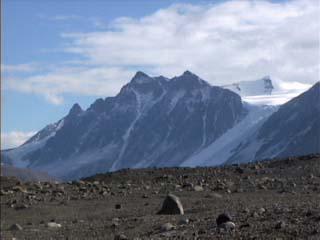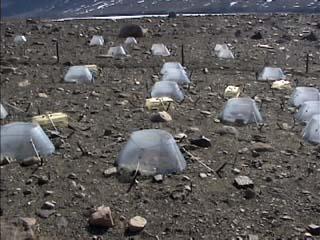12 January, 2001
A stacked pile of 2x4's provides a temporary bench for us to sit on. The
three of us are sharply dressed in our issued extreme cold weather (ECW)
gear, bright red jackets and black windpants. Color is one of the things
you miss in Antarctica. This lack of color permeates everything. The
continent is white and black. The US Polar Program issued clothing is black
and red. Even McMurdo is an extension of this lack of color. The buildings
are mud brown or navaho.
Sitting to my right is Allison Shelley, a photographer working for
Education week. Allison is an attractive, charismatic woman with a warm
smile. She has a gift of capturing the moment. To my left is David Hoff a
reporter for the same publication, he is tall and lean and has a
comforting, quiet nature about him. David always appears in thought, like
he is searching for the appropriate words to capture the moment. Job hazard
. Both are here collaborating on a story about the TEA program,
individually they are using their own media to describe their Antarctic
experience. We have been waiting by the helo pad for our ride in the Astar
helicopter back to McMurdo.
This was my first visit to the site F6 located in the Taylor Valley, one of
the Dry Valleys. It was incredible to finally be in a place I have been
reading about for a year. The Dry Valleys are often compared to the martian
surface. Sitting here, I would have to agree. Some of our science equipment
even resembles the Viking probes used by NASA. Rocks of various sizes and
colors litter the valley floor. The air in the valley is so clear that the
mountains appear to be minutes away. In reality itís hours. The only sounds
in the valley come from us and they seem out of place. Almost alien.
F6 is one of the LTER sites where Dr. Virginia and Dr. Wall have long term
experiments set-up. The newest experiment, set-up last week, is a snow
fence. Researchers have made the observation that snow usually accumulates
in the Dry Valleys on the leeward side of mountains. The idea is that the
fence will simulate this effect and allow for the accumulation of snow.
Since life in the valleys is associated with the presence of water; more
water, means more organisms! Now that the fence is up, the research team
will have to wait and see if this is true. A second experiment is the
warming chamber experiment or ìworm farmsî. Rows of plastic cones tethered
to the earth with bungee cords. These warming chambers have been in the
field for about eight years. Originally the idea was that the chambers
would increase the temperature of the soil inside and thus increase the
biological activity in the soil. Now with eight years of data to look at a
trend is emerging that suggests the increased soil temperature dries out
the soils. So far no significant effects in the biological activity have
been noted.

While both nervous and excited, my first ride in the helo was great! I can't wait to do it again.

Taylor Valley

This was the view of the Matterhorn from our 2x4 bench.

Warming chambers or what are commonly called "worm farms".
Contact the TEA in the field at
.
If you cannot connect through your browser, copy the
TEA's e-mail address in the "To:" line of
your favorite e-mail package.
|
